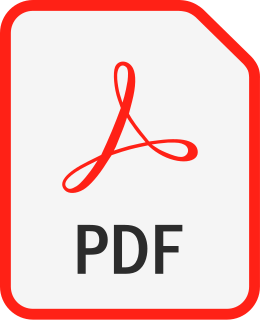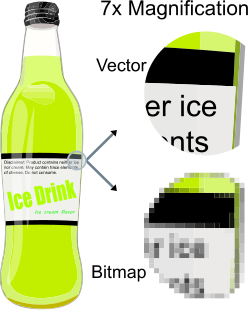
Portable Document Format (PDF), standardized as ISO 32000, is a file format developed by Adobe in 1992 to present documents, including text formatting and images, in a manner independent of application software, hardware, and operating systems. Based on the PostScript language, each PDF file encapsulates a complete description of a fixed-layout flat document, including the text, fonts, vector graphics, raster images and other information needed to display it. PDF has its roots in "The Camelot Project" initiated by Adobe co-founder John Warnock in 1991.

Portable Network Graphics is a raster-graphics file format that supports lossless data compression. PNG was developed as an improved, non-patented replacement for Graphics Interchange Format (GIF) — unofficially, the initials PNG stood for the recursive acronym "PNG's not GIF".

Vector graphics, as a form of computer graphics, is the set of mechanisms for creating visual images directly from geometric shapes defined on a Cartesian plane, such as points, lines, curves, and polygons. These mechanisms may include vector display and printing hardware, vector data models and file formats, and software based on these data models. Vector graphics is an alternative to raster graphics, each having advantages and disadvantages in general and in specific situations.

The Meaning of Liff is a humorous dictionary of toponymy and etymology, written by Douglas Adams and John Lloyd, published in the United Kingdom in 1983 and the United States in 1984.

Tag Image File Format, abbreviated TIFF or TIF, is an image file format for storing raster graphics images, popular among graphic artists, the publishing industry, and photographers. TIFF is widely supported by scanning, faxing, word processing, optical character recognition, image manipulation, desktop publishing, and page-layout applications. The format was created by the Aldus Corporation for use in desktop publishing. It published the latest version 6.0 in 1992, subsequently updated with an Adobe Systems copyright after the latter acquired Aldus in 1994. Several Aldus or Adobe technical notes have been published with minor extensions to the format, and several specifications have been based on TIFF 6.0, including TIFF/EP, TIFF/IT, TIFF-F and TIFF-FX.
The BMP file format, also known as bitmap image file, device independent bitmap (DIB) file format and bitmap, is a raster graphics image file format used to store bitmap digital images, independently of the display device, especially on Microsoft Windows and OS/2 operating systems.

Exchangeable image file format is a standard that specifies the formats for images, sound, and ancillary tags used by digital cameras, scanners and other systems handling image and sound files recorded by digital cameras. The specification uses the following existing file formats with the addition of specific metadata tags: JPEG discrete cosine transform (DCT) for compressed image files, TIFF Rev. 6.0 for uncompressed image files, and RIFF WAV for audio files. It is not used in JPEG 2000 or GIF.
DjVu is a computer file format designed primarily to store scanned documents, especially those containing a combination of text, line drawings, indexed color images, and photographs. It uses technologies such as image layer separation of text and background/images, progressive loading, arithmetic coding, and lossy compression for bitonal (monochrome) images. This allows high-quality, readable images to be stored in a minimum of space, so that they can be made available on the web.
Netpbm is an open-source package of graphics programs and a programming library. It is used mainly in the Unix world, where one can find it included in all major open-source operating system distributions, but also works on Microsoft Windows, macOS, and other operating systems.
A container format or metafile is a file format that allows multiple data streams to be embedded into a single file, usually along with metadata for identifying and further detailing those streams. Notable examples of container formats include archive files and formats used for multimedia playback. Among the earliest cross-platform container formats were Distinguished Encoding Rules and the 1985 Interchange File Format.
Liff or LIFF may refer to:
Image file formats are standardized means of organizing and storing digital images. An image file format may store data in an uncompressed format, a compressed format, or a vector format. Image files are composed of digital data in one of these formats so that the data can be rasterized for use on a computer display or printer. Rasterization converts the image data into a grid of pixels. Each pixel has a number of bits to designate its color. Rasterizing an image file for a specific device takes into account the number of bits per pixel that the device is designed to handle.
A camera raw image file contains minimally processed data from the image sensor of either a digital camera, a motion picture film scanner, or other image scanner. Raw files are named so because they are not yet processed and therefore are not ready to be printed or edited with a bitmap graphics editor. Normally, the image is processed by a raw converter in a wide-gamut internal color space where precise adjustments can be made before conversion to a "positive" file format such as TIFF or JPEG for storage, printing, or further manipulation. There are dozens of raw formats in use by different manufacturers of digital image capture equipment.
The Windows Imaging Format (WIM) is a file-based disk image format. It was developed by Microsoft to help deploy Windows Vista and subsequent versions of the Windows operating system family, as well as Windows Fundamentals for Legacy PCs.
Silicon Graphics Image (SGI) or the RGB file format is the native raster graphics file format for Silicon Graphics workstations. The format was invented by Paul Haeberli. It can be run-length encoded (RLE). FFmpeg and ImageMagick, among others, support this format.

A comic book archive or comic book reader file is a type of archive file for the purpose of sequential viewing of images, commonly for comic books. The idea was made popular by the CDisplay sequential image viewer; since then, many viewers for different platforms have been created.
In computing, a bitmap is a mapping from some domain to bits. It is also called a bit array or bitmap index.
A file format is a standard way that information is encoded for storage in a computer file. It specifies how bits are used to encode information in a digital storage medium. File formats may be either proprietary or free.
ISO/IEC base media file format (ISOBMFF) defines a general structure for time-based multimedia files such as video and audio. It is standardized in ISO/IEC 14496-12, a.k.a. MPEG-4 Part 12, and was formerly also published as ISO/IEC 15444-12, a.k.a. JPEG 2000 Part 12.
High Efficiency Image File Format (HEIF) is a container format for storing individual images and image sequences. The standard covers multimedia files that can also include other media streams, such as timed text, audio and video.





